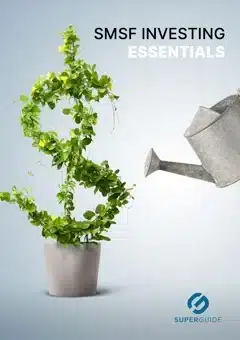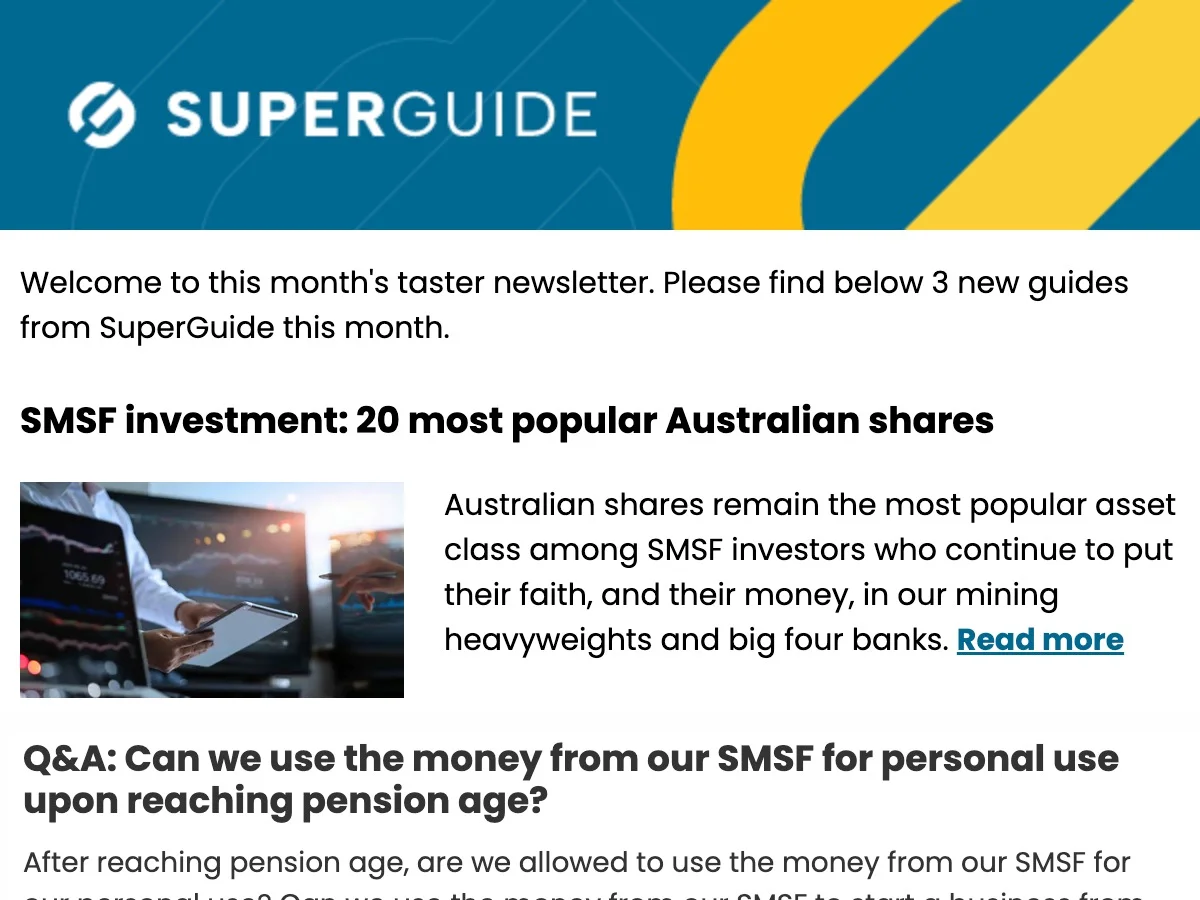Exchange-traded funds (ETFs) continue to cement their role in SMSF portfolios, with more than one in three (34.1%) Class SMSFs holding them, and the only major asset class to grow in popularity in 2024–25.
This puts ETFs ahead of traditional managed funds (31.5% of Class SMSFs) and direct property (26.7%), despite being a relatively young investment product.
ETFs were launched in the US in the 1990s and took off globally in the noughties. Global assets under management reached a phenomenal US$17 trillion as at June 2025.
In Australia, there were 388 ETFs listed on the ASX and 39 listed on Cboe Australia, valued at more than $272 billion, up $33 billion in the year to June 2025.
As the name suggests, ETFs can be bought and sold on the ASX like ordinary shares but offer the diversification of managed funds.
2026 SMSF calendar
Our free calendar includes due dates for important documents plus suggested dates for trustee meetings and other strategic issues for your SMSF.
"*" indicates required fields
Each ETF is designed to reflect the performance of a particular market – whether that’s a share index such as the ASX200 or the S&P500, a grouping of national markets such as Emerging Markets, an industry such as Healthcare or an asset class such as Global Fixed Interest.
As the Class Report points out, ETFs now cover all major sectors, regions and management styles, so SMSFs can make up a diverse portfolio using ETFs alone.
The popularity of ETFs is being fuelled by the growing take-up of SMSFs by Generation X and Millennials. In the 2025 financial year, 35–44-year-olds made up 33.2% of new SMSF establishments, while 45–49-year-olds accounted for 19.2%, against a big drop in new fund establishments by ageing Baby Boomers.
SMSF investors have embraced ETFs because they offer a simple, easy-to-trade, low-cost way to diversify, especially when it comes to global markets. Because most ETFs are passively managed – tracking an entire index rather than picking winners – fees are generally low.
Increased competition has pushed fees lower, beginning from as little as 0.03%, with the average management expense ratio (MER) around 0.33%. Index-tracking ETFs have the lowest fees, while thematic active ETFs typically have higher fees. And, as we all know, low fees boost net returns.
As well as cost and ease of trading, ETFs allow self-directed investors to plug gaps in their portfolio as well as make tactical changes to their asset allocation in response to market moves.

Free eBook
SMSF investing essentials
Learn the essential facts about the SMSF investment rules, how to create an investment strategy (including templates) and how to give your strategy a healthcheck.
"*" indicates required fields
Financial advisers have also come on board, as ETFs offer a simple way of building a diversified portfolio, often using a core and satellite approach. The core component generally includes broad asset classes such as Australian or US shares, while the satellite component may include active or thematic components such as semiconductors or climate change.
While 34.1% of Class SMSFs held ETFs in June 2025 (up from 32.0%), ETFs accounted for just 6.1% (or $21.5 billion) of total SMSF assets, up 0.8 percentage points over the year.
International and domestic ETFs
As you can see in the table below, the most popular ETFs are generally low-cost and split almost 50:50 between domestic and international funds. Six of the top 10 provide exposure to international shares, highlighting how SMSFs use ETFs to gain international exposure and diversify risk.
That said, Vanguard’s Australian Shares Index ETF continues to rule the roost, held by 13.5% of SMSFs, with ETFs representing 6.3% of total SMSF ETF investments worth $1.4 billion.
The iShares S&P 500 ETF and VanEck Vectors MSCI World ex Australia Quality ETF come next in popularity, both held by 12.8% of funds with ETFs, worth 5.0% and 3.3% of total SMSF ETF investments, respectively. The iShares ETF provides investors with exposure to booming tech stocks such as Apple, Google, Microsoft and NVIDIA for a low management fee of just 0.04% per year.
Magellan made a partial comeback, with its Global Fund roaring back from 19th place to 12th while its Infrastructure Fund dropped out of the rankings entirely.
Supercharge your SMSF

"*" indicates required fields
Two new entrants to the top 20 were bond funds – the iShares Core Composite Bond ETF and Betashares Australian Bank Senior Floating Rate Bond ETF. Australian and international bonds had their best year since 2018–19, up 6.8% and 5.4% respectively in the 12 months to June 2025.
20 most popular ETFs invested in by SMSFs
The top 20 list below is ranked by the percentage of SMSFs holding these ETFs, rather than the percentage each security makes up of total SMSF investments in ETFs, although both figures are provided in the table.
| Rank | Security code | Description | International or Domestic | % of funds with ETFs that hold this security | % of total SMSF ETF investments |
|---|---|---|---|---|---|
| 1 | VAS | Vanguard Australian Shares Index ETF – Exchange Traded Fund Units Fully Paid | Domestic | 13.5% | 6.3% |
| 2 | QUAL | VanEck Vectors MSCI World ex Australia Quality ETF – Exchange Traded Fund Units Fully Paid | International | 12.8% | 3.3% |
| 3 | IVV | Ishares S&P 500 ETF – Exchange Traded Fund Units Fully Paid | International | 12.8% | 5.0% |
| 4 | VGS | Vanguard MSCI Index International Shares ETF – Exchange Traded Fund Units Fully Paid | International | 10.8% | 4.0% |
| 5 | VAP | Vanguard Australian Property Securities Index ETF – Exchange Traded Fund Units Fully Paid | Domestic | 10.6% | 1.9% |
| 6 | VEU | Vanguard All-World Ex-US Shares Index ETF – Chess Depositary Interests 1:1 | International | 10.1% | 2.0% |
| 7 | NDQ | Betashares Nasdaq 100 ETF – Exchange Traded Fund Units Fully Paid | International | 8.8% | 2.2% |
| 8 | IOO | Ishares Global 100 ETF – Exchange Traded Fund Units Fully Paid | International | 8.3% | 2.9% |
| 9 | VHY | Vanguard Australian Shares High Yield ETF – Exchange Traded Fund Units Fully Paid | Domestic | 8.1% | 2.4% |
| 10 | VTS | Vanguard US Total Market Shares Index ETF – Chess Depositary Interests 1:1 | International | 7.9% | 2.6% |
| 11 | A200 | BetaShares Australia 200 ETF | Domestic | 7.7% | 2.1% |
| 12 | MGOC | Magellan Global Fund (Open Class) | International | 7.3% | 1.9% |
| 13 | VGAD | Vanguard MSCI Index International Shares (Hedged) | International | 7.0% | 2.4% |
| 14 | MVW | Vaneck Vectors Australian Equal Weight ETF – Exchange Traded Fund Units Fully Paid | Domestic | 6.8% | 1.7% |
| 15 | HBRD | Betashares Active Australian Hybrids Fund (Manged Funds) | Domestic | 6.4% | 1.7% |
| 16 | STW | SPDR S&P/ASX 200 Fund – Exchange Traded Fund Units Fully Paid | Domestic | 6.4% | 2.7% |
| 17 | AAA | Betashares Australian High Interest Cash ETF – Exchange Traded Fund Units Fully Paid | Domestic | 6.3% | 1.3% |
| 18 | IAF | Ishares Core Composite Bond ETF | Domestic | 5.8% | 1.0% |
| 19 | IOZ | Ishares CORE S&P/ASX 200 ETF | Domestic | 5.8% | 1.9% |
| 20 | QPON | Betashares Australian Bank Senior Floating Rate Bond ETF | Domestic | 5.6% | 1.3% |
| Total (Percentage that the top 20 make up of total SMSF investments in exchange-traded funds) | 50.8% | ||||
Source: Class. Data as of 30 June 2025. Data sourced from 181,862 SMSFs that use Class software.
There are a dozen ETF providers in Australia, but the market (and the Class top 20) is dominated by Vanguard with 28.6% of the market by value, Betashares with 20.0%, BlackRock with 18.6% and VanEck with 13.0%.



Leave a Reply
You must be logged in to post a comment.